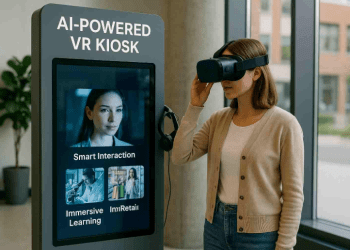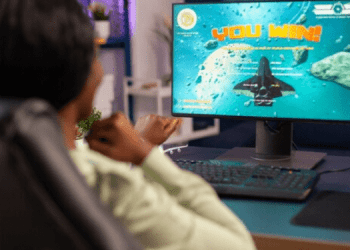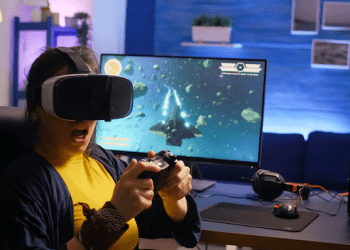Virtual reality is transforming the healthcare industry. This innovative technology enhances medical training simulations for healthcare professionals. Virtual reality developers play a crucial role in creating these immersive experiences. Their work enables effective and engaging VR medical training.
As we explore the impact of virtual reality in healthcare, we’ll highlight its advantages. Additionally, we’ll examine key applications and the future of this groundbreaking technology.
Advantages of VR in Medical Training
The integration of VR into medical training offers several benefits that traditional methods cannot match.
- Risk-Free Environment: Trainees can practice procedures repeatedly without the risk of harming patients, which is crucial for mastering delicate operations. This allows for the development of muscle memory and technique refinement, which are essential for surgical precision.
- Realistic Simulations: VR provides highly detailed simulations of human anatomy and surgical procedures, allowing for a deeper understanding of complex medical concepts. These simulations can mimic real-life scenarios closely, preparing trainees for a wide range of potential challenges they may face in their careers.
- Immediate Feedback: VR systems can provide instant feedback on performance, enabling learners to quickly identify and correct mistakes. This immediate response loop fosters a learning environment where mistakes are seen as opportunities for growth rather than setbacks.
The adaptability of VR training modules also means they can be updated to reflect the latest medical research and techniques, keeping healthcare professionals at the forefront of medical advancements. These advantages underscore the importance of VR in elevating the standards of medical training and ensuring that healthcare professionals are thoroughly prepared for their roles.
Diverse Applications of VR in Medical Training
Virtual reality technology is revolutionizing a variety of medical training fields, enhancing learning experiences and outcomes in diverse disciplines. Here are some notable areas where VR is proving to be particularly effective:
- Eye Surgery Training: VR simulations allow ophthalmology trainees to practice delicate procedures, such as cataract surgery, in a controlled environment. This technology offers realistic 3D visuals of the eye’s anatomy and allows for repeated practice of surgical techniques, which is essential for developing precision in eye care.
- Dental Industry: Dental students can benefit from VR by practicing procedures like cavity fillings, extractions, and orthodontics. Using VR, they can work on realistic dental scenarios and improve their skills without the pressure of working on live patients, thus enhancing their confidence before entering clinical practice.
- Psychology Training: In the field of psychology, VR can be used for exposure therapy, where trainees practice scenarios with patients experiencing anxiety or phobias in a safe and controlled environment. This immersive experience helps train therapists in managing real-life situations and understanding patient responses effectively.
- Surgical Specialties: Beyond eye surgery, various surgical specializations such as orthopedic, cardiovascular, and neurosurgery can utilize VR simulations for training. Trainees can familiarize themselves with complex procedures and enhance their understanding of anatomy through hands-on practice in a risk-free setting.
- Emergency Response Training: VR can simulate emergency scenarios, allowing healthcare professionals to practice critical decision-making and life-saving techniques in high-pressure situations. This training can be pivotal in preparing responders for real-life emergencies, ultimately improving patient care during crises.
- Nursing and Patient Care: Nurse training can also benefit from VR by simulating patient interactions, symptom assessment, and the management of care situations. This technology allows nursing students to develop their communication and bedside manners in simulated environments.
Pros and Cons of VR Training in Healthcare
Pros:
- Risk-Free Learning Environment: VR allows healthcare professionals to practice procedures without the fear of harming real patients. This risk-free setting encourages experimentation and learning from mistakes.
- Enhanced Realism and Engagement: The immersive experience provided by VR can lead to greater engagement and retention of information, as trainees can practice in lifelike scenarios that closely mimic real-life situations.
- Immediate Feedback: VR systems provide instant feedback on performance, helping learners identify and rectify mistakes quickly, which accelerates the learning process.
- Cost-Effective Training: Although the initial setup cost may be high, VR can ultimately reduce training time and costs associated with medical errors, leading to greater efficiency in training programs.
- Accessibility: VR makes training more accessible, especially for professionals in remote areas, allowing them to receive high-quality training without geographical limitations.
- Adaptability to Latest Techniques: VR training modules can be easily updated to reflect the latest medical research and procedures, ensuring that healthcare professionals remain current in their practices.
Cons:
- High Initial Investment: The cost of VR hardware and software can be prohibitive for some institutions, potentially limiting widespread adoption.
- Technical Challenges: Implementing and maintaining VR systems can present technical challenges, including software updates, hardware malfunctions, and the need for ongoing tech support.
- Learning Curve: Some healthcare professionals may struggle with the technology, requiring additional training to feel comfortable using VR systems effectively.
- Limited Scenarios: While VR is effective for many training scenarios, there are still limitations in simulating complex human interactions or unpredictable real-life situations that healthcare professionals face.
- Potential for Over-reliance on Technology: There is a risk that trainees may become too reliant on VR simulations, which could lead to gaps in traditional hands-on training and clinical experience.
- Ethical Considerations: As VR training becomes more prevalent, ethical considerations regarding patient privacy and the representation of medical conditions in simulations must be addressed to ensure responsible use of the technology.
Vision Pro: Leading the Charge
Vision Pro is poised to be a game-changer in the realm of VR medical training. Its advanced capabilities and user-friendly interface make it an ideal tool for both developers and healthcare professionals. The system’s design prioritizes ease of use and accessibility, ensuring that its benefits can be harnessed by a wide audience, regardless of their technical proficiency.
Features of Vision Pro
- Enhanced Graphics and Realism: Vision Pro offers unparalleled graphical fidelity, ensuring that medical simulations are as close to reality as possible. This level of detail is essential for accurately replicating the complexity of human anatomy and medical procedures.
- Intuitive User Interface: The system’s interface is designed to be accessible to users with varying levels of technical expertise, making it easier for healthcare professionals to adopt and utilize. This user-centric design reduces the learning curve, allowing users to focus on skill development rather than technology navigation.
- Collaborative Capabilities: Vision Pro supports multi-user scenarios, allowing for collaborative training sessions and remote learning opportunities. This feature is particularly beneficial in fostering teamwork and communication skills, which are crucial in the medical field.
Additionally, Vision Pro’s adaptability allows it to be integrated into various educational curriculums, providing a versatile platform for both teaching and learning. These features make Vision Pro an invaluable asset in the development of effective VR medical training simulations, setting a new standard for what is possible in medical education.
The Role of VR Application Developers
For VR to reach its full potential in healthcare, the role of VR application developers is crucial. These developers need to possess a deep understanding of both gaming mechanics and medical requirements to create effective simulations. Their work bridges the gap between technological innovation and practical medical application, ensuring that VR tools meet the rigorous demands of the healthcare industry.
Challenges in Developing Medical VR Applications
Developers face several challenges in this burgeoning field.
- Accuracy and Precision: Medical simulations must be highly accurate to be effective. Virtual reality developersneed to work closely with medical professionals to ensure simulations reflect real-world scenarios. This collaboration is vital to create an educational experience that is both realistic and informative.
- Complexity of Medical Procedures: Translating complex medical procedures into VR requires a thorough understanding of both the medical and technical aspects. This necessitates a multidisciplinary approach, where developers must learn the intricacies of medical science alongside their technical expertise.
- User Experience: Creating an intuitive and engaging user experience is critical for adoption by healthcare professionals who may not be familiar with VR technology. Developers must design interfaces that are not only functional but also intuitive, ensuring that users can seamlessly interact with the simulations.
Moreover, developers must consider the ethical implications of their work, ensuring that simulations are designed to enhance learning without compromising patient privacy or data security. Despite these challenges, the potential rewards for developers who successfully create impactful medical VR applications are significant, opening new avenues for innovation and career advancement.
Implications for the Healthcare Industry
The adoption of VR in medical training has far-reaching implications for the healthcare industry. The shift towards virtual learning environments not only enhances educational outcomes but also reshapes how healthcare services are delivered and perceived.
Improved Training Outcomes
VR simulations can lead to better-trained healthcare professionals, resulting in improved patient outcomes and reduced errors in medical procedures. These improvements can translate into higher levels of patient satisfaction and trust in the healthcare system. By equipping practitioners with more comprehensive training, VR has the potential to raise the standard of care across the board.
Cost-Effectiveness
While the initial investment in VR technology may be high, the long-term cost savings from reduced training time and improved efficiency can be substantial. Institutions can allocate resources more effectively, prioritizing patient care over prolonged training sessions. Additionally, VR can help reduce the costs associated with medical errors, further emphasizing its financial benefits.
Accessibility
VR can make medical training more accessible, allowing professionals in remote or underserved areas to receive the same level of training as those in major medical centers. This democratization of education can lead to a more equitable healthcare system, where geography is no longer a barrier to high-quality training. VR facilitates a global exchange of knowledge, promoting international standards and collaboration.
These implications suggest that VR has the potential to democratize medical education and improve healthcare delivery worldwide. As more institutions adopt VR, the healthcare industry will likely see a shift towards more efficient, effective, and inclusive practices.
Future Directions and Opportunities
As VR technology continues to advance, several exciting opportunities lie on the horizon. The potential for innovation is vast, with VR poised to impact various facets of healthcare beyond just training.
- Integration with AI: Combining VR with artificial intelligence could lead to even more personalized and adaptive training experiences. AI can analyze user performance data to tailor simulations to individual needs, enhancing the learning experience and outcomes.
- Expansion Beyond Training: VR could be used for patient education, rehabilitation, and even therapy, broadening its impact on healthcare. Patients could engage with immersive environments for pain management or mental health treatment, illustrating the versatility of VR.
- Global Collaboration: VR enables collaboration across geographical boundaries, fostering a global community of healthcare professionals sharing knowledge and expertise. This interconnectedness can drive innovation and accelerate the dissemination of best practices.
Additionally, the emergence of VR as a tool for telemedicine could revolutionize how care is provided, especially in areas with limited access to healthcare facilities. These opportunities highlight the potential for VR to transform not just medical training, but the entire healthcare landscape, paving the way for a future where technology and medicine are seamlessly integrated.
Conclusion
The convergence of virtual reality and healthcare represents a frontier of innovation with Vision Pro at the helm. By enabling highly realistic medical training simulations, VR has the power to transform the way medical professionals learn and practice. As VR application developers continue to refine these technologies, the healthcare industry stands on the brink of a new era marked by improved training, greater accessibility, and enhanced patient care. Embracing this revolution could be the key to unlocking a future where healthcare is more effective, efficient, and equitable for all. The journey towards integrating VR in healthcare is only just beginning, and its potential to reshape the industry is limitless.
Frequently Asked Questions (FAQ) – VR in Healthcare Training
1. What is VR training in healthcare?
VR training uses virtual reality technology to simulate clinical environments and medical procedures, allowing healthcare professionals to practice skills in a safe, controlled setting.
2. How does VR enhance medical education?
VR offers immersive, hands-on learning experiences that boost engagement, knowledge retention, and practical skills—without risking patient safety.
3. What are some examples of VR applications in healthcare?
Common uses include:
- Surgical training (e.g., eye or orthopedic surgery)
- Dental education
- Emergency response simulations
- Mental health and psychological therapy
- Nursing and ICU scenario training
4. What are the downsides or limitations of VR training?
Some challenges include:
- High initial setup and hardware costs
- Technical complexity and software updates
- A learning curve for new users
- Risk of over-dependence on simulation rather than real-world practice
5. Can VR be used for patient education?
Yes. VR can help patients understand procedures, visualize treatment plans, and reduce anxiety by providing an interactive, engaging learning experience.
6. How does VR ensure safety during training?
VR enables healthcare learners to make decisions, perform procedures, and respond to critical situations in a zero-risk environment, where mistakes become learning opportunities.
7. What is the future of VR in healthcare training?
The future will likely include:
- Integration of artificial intelligence (AI) for adaptive feedback
- Enhanced telemedicine support
- Broader applications in physical therapy, rehabilitation, and chronic disease management










